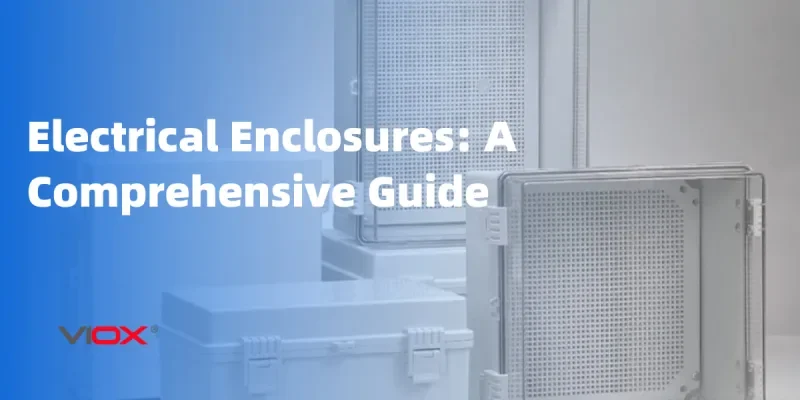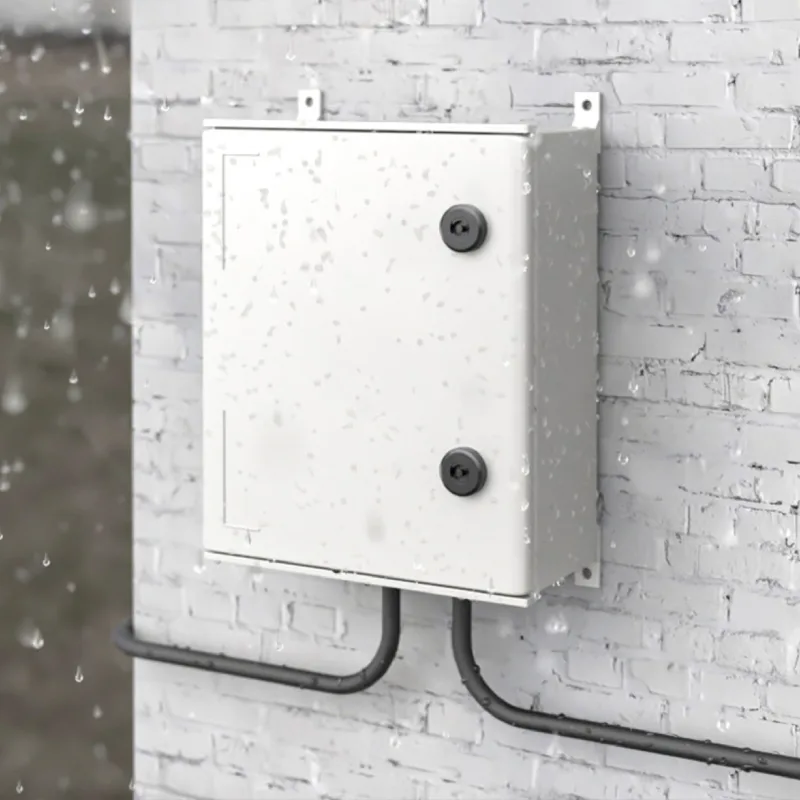An electrical enclosure is a protective housing that shields electrical components from environmental hazards, unauthorized access, and physical damage while ensuring code compliance and operational safety. Choosing the right enclosure prevents equipment failure, reduces fire risks, and meets NEC (Nationaler Elektrocode) requirements that govern electrical installations across residential, commercial, and industrial applications.
What Is an Electrical Enclosure?
An electrical enclosure is a manufactured box or cabinet designed to contain and protect electrical equipment such as Leistungsschalter, switches, transformers, and control panels. These protective housings serve three critical functions: environmental protection, safety compliance, and operational accessibility.
Key Components of Electrical Enclosures:
- Material des Gehäuses: Steel, stainless steel, aluminum, fiberglass, or plastic construction
- Sealing System: Gaskets, weatherstripping, or welded seams for environmental protection
- Access Features: Hinged doors, removable covers, or latching mechanisms
- Montage-Optionen: Wall-mount, floor-stand, or pole-mount configurations
- Interne Komponenten: DIN rails, grounding bars, and component mounting systems
Types of Electrical Enclosures: Complete Comparison
NEMA Rating Classifications
| NEMA Rating | Schutzniveau | Typische Anwendungen | Indoor/Outdoor | Wesentliche Merkmale |
|---|---|---|---|---|
| NEMA 1 | General purpose | Indoor trockene Standorte | Innenbereich | Basis-Schutz vor versehentlichem Kontakt |
| NEMA 3R | Wetterfest | Bei Installationen im freien | Im Freien | Regen, Graupel, Schnee Schutz mit ablauflöchern |
| NEMA 4 | Wasserdichte | Washdown Gebieten, Küsten - | Beide | Komplette Wasser-Schutz, Dichtung Dichtungen |
| NEMA 4X | Korrosionsbeständig | Chemische Pflanzen, marine | Beide | Edelstahl/GFK, Chemische Beständigkeit |
| NEMA 12 | Industrie | Herstellung Etagen | Innenbereich | Staub -, öl -, Kühlmittel-Schutz |
| NEMA 6P | Tauchpumpen | Unten-grade-Anlagen | Beide | Vorübergehende überflutung Schutz |
Werkstoff-Vergleichstabelle
| Material | Kosten | Dauerhaftigkeit | Korrosionsbeständigkeit | Gewicht | Beste Anwendungen |
|---|---|---|---|---|---|
| Carbon Stahl | Niedrig | Hoch | Poor (erfordert Beschichtung) | Schwer | Innen, trockenen Umgebungen |
| Rostfreier Stahl | Hoch | Sehr hoch | Ausgezeichnet | Schwer | Chemische, marine, Nahrungsmittel Verarbeitung |
| Aluminium | Medium | Hoch | Gut | Licht | Outdoor, Gewicht sensiblen Anwendungen |
| GFK | Mittel-Hoch | Hoch | Ausgezeichnet | Licht | Korrosive Umgebungen, Küsten - |
| Polycarbonat | Gering-Mittel | Medium | Gut | Sehr Leicht | Non-metallic Anforderungen, RF Transparenz |
Verständnis NEMA-Kenndaten vs IP Ratings
NEMA (National Electrical Manufacturers Association) Bewertungen North American standards, die angeben, Schutzart Ebenen, während IP-Schutz (Ingress Protection) sind internationale standards weltweit.
NEMA-zu-IP-Umwandlung Referenz
| NEMA Rating | Equivalent IP Rating | Schutz Beschreibung |
|---|---|---|
| NEMA 1 | IP10 | Schutz von >50mm Objekte |
| NEMA 3R | IP24 | Schutz vor Regen und >12mm Objekte |
| NEMA 4 | IP65 | Staubdicht und Strahlwasser-Schutz |
| NEMA 4X | IP65 | Staubdicht, Wasser-jet, Korrosion beständig |
| NEMA 12 | IP54 | Begrenzte Staub und Wasser splash Schutz |
| NEMA 6P | IP67 | Staubdicht und kurzzeitiges eintauchen in Wasser |
🔍 Experten-Tipp: NEMA-Kenndaten zusätzliche Leistungskriterien über IP-Schutzklassen, wie Korrosion Widerstand, Bau-Anforderungen und Prüfung standards, die spezifisch für Nord-amerikanische Verhältnisse.
Wichtige Anwendungen und Anwendungsfälle
Anwendungen für Wohnzwecke
- Wichtigsten elektrischen panels: NEMA 1 oder 3R je nach Standort
- Meter Basen: NEMA 3R für die installation im Außenbereich
- Pool Ausrüstung: NEMA 4X für Chlor Widerstand
- Außensteckdosen: NEMA 3R wetterfeste Boxen
Kommerzielle Anwendungen
- HVAC: NEMA 1 für den innen -, NEMA 4 für Dach Einheiten
- Lichtsteuerung: NEMA 1 für office Gebäude
- Sicherheitssysteme: NEMA 4 für outdoor Kameras und access controls
- Feuer-alarm-panels: NEMA 1 mit spezifischen UL-Zertifizierungen
Industrielle Anwendungen
- Motorsteuerungszentren: NEMA 12 für die Herstellung von Umgebungen
- Prozess-Steuerung: NEMA 4X für die Chemische Verarbeitung
- Instrumentation: NEMA 4 für die Messung und überwachung
- Stromverteilung: NEMA 3R für outdoor-Unterstationen
Wie Wählen Sie die Richtige Elektrische Gehäuse
Schritt 1: Überprüfen Der Umgebungsbedingungen
- Standort: Indoor-vs. outdoor-Anforderungen an die installation
- Feuchtigkeitseinwirkung: Regen, Spritzwasser, Luftfeuchtigkeit
- Temperaturbereich: Betrieb und Lagerung Temperatur Grenzen
- Chemische Belastung: Das Vorhandensein korrosiver Stoffe
- Physikalische Gefahren: Schlag, vibration, oder Sicherheits-Bedenken
Schritt 2: Bestimmen Sie Größe Anforderungen
- Komponenten-Inventar: Liste alle Geräte untergebracht werden
- Wärmeableitung: Berechnen Sie die thermische Last und Lüftung muss
- Zugangsvoraussetzungen: Service-Abstände und die Arbeit Raum
- Zukünftige Erweiterung: Gestatten Sie 25% zusätzlichen Raum für Modifikationen
- Code compliance: Treffen der NEC-Artikel 110.26 arbeiten Platzbedarf
Schritt 3: Material Auswahl-Kriterien
Wählen Sie Aus Edelstahl, Wenn:
- Chemische Exposition vorhanden ist
- Meeres-und Küsten Umgebungen
- Lebensmittel Verarbeitung Anwendungen
- Langfristige Korrosion Widerstand ist entscheidend
Wählen Sie Aluminium, Wenn:
- Gewicht Reduktion ist wichtig
- Gute Korrosionsbeständigkeit erforderlich ist
- Kosten-Wirksamkeit ist eine Priorität
- Outdoor-Anwendungen ohne extreme Chemikalien
Carbon Stahl, Wenn:
- Indoor, kontrollierten Umgebungen
- Budget-Einschränkungen vorhanden
- Hohe mechanische Festigkeit erforderlich ist
- Richtige Beschichtung gehalten werden kann
Schritt 4: Überprüfen Der Compliance Code
- NEC-Artikel 312: Schränke, Ausschnitt Boxen und meter Buchse Gehäuse
- NEC-Artikel 314: Steckdose, Gerät, ziehen, und Anschlussdosen
- Lokale änderungen: Check kommunalen elektrischen codes
- UL Inserate: Sicherstellen, dass eine entsprechende Zertifizierung für die Anwendung
⚠️ Sicherheit Warnung: Konsultieren Sie immer den örtlichen elektrischen codes und Behörden having jurisdiction (AHJ) vor der Finalisierung Gehäuse-Auswahl. Nicht-konforme Installationen may result in safety hazards und Inspektion Fehler.
Installation Best Practices
Planung vor der Installation
- Site survey: Überprüfen Sie die Montage Oberfläche und Zugänglichkeit
- Conduit routing: Plan Einstiegspunkte und Kabel-management
- Erdungsanforderungen: Sicherstellen, dass eine ordnungsgemäße Verklebung Bestimmungen
- Abstandsprüfung: Bestätigen working space pro NEC 110.26
Installationsprozess
- Montage Vorbereitung:- Ebene und sichere Oberfläche Montage
- Gehäuse Positionierung: Verwenden Sie geeignete Befestigungen für Substrat
- Conduit connections: Installieren Sie die richtigen Beschläge und Dichtungen
- Erdung installation: Verbinden Sie den Schutzleiter
- Für die installation der Komponenten: Mount-Ausrüstung mit den richtigen Abstand
- Abschließende Prüfung: Überprüfen Sie die verbindungen und Schutzsysteme
Zu vermeidende Fehler bei der Installation
- Unzureichende Abdichtung: Kompromisse NEMA rating-Schutz
- Unsachgemäße Erdung: Erstellt von Gefahren und Verstößen gegen den Kodex
- Overpacking: Reduziert die Wärmeableitung und Zugänglichkeit
- Falsch conduit fittings: Ermöglicht das gegen Feuchtigkeit und Verschmutzungen Eintrag
- Ungenügende Abstände: Gegen NEC working space Anforderungen
Problemlösung Häufige Probleme Gehäuse
Das Eindringen Von Feuchtigkeit Probleme
Symptome: Kondensation, Korrosion, Ausfall der Anlage
Lösungen:
- Überprüfen Sie die Dichtung Zustand und die ordnungsgemäße Kompression
- Check drain-Löcher für die Blockade (NEMA 3R Gehäuse)
- Installieren Heizungen oder Lüftungsanlagen für Temperatur control
- Upgrade auf höhere NEMA rating ggf.
Überhitzungsprobleme
Symptome: Ausfälle, verkürzt die Lebensdauer der Komponente
Lösungen:
- Fügen Sie Lüfter oder Lüftungsöffnungen
- Erhöhen Gehäuse für besser Wärmeableitung
- Installieren Wärmetauscher für extreme Bedingungen
- Verlegen wärmeerzeugenden Komponenten
Korrosion Betrifft
Symptome: Oberfläche Rost, material degradation
Lösungen:
- Upgrade auf Edelstahl oder Aluminium
- Gelten die Schutz-Beschichtungen auf Kohlenstoff-Stahl
- Verbesserung der Belüftung und reduzieren die Feuchtigkeit
- Betrachten kathodischen Schutz für vergrabene Anwendungen
Auswahl-Matrix
Kurzanleitung zur Auswahl
| Anwendung Typ | Umwelt | Empfohlen NEMA | Material Wahl | Besondere Überlegungen |
|---|---|---|---|---|
| Wohn-Panel | Innenbereich | NEMA 1 | Carbon Stahl | UL-Gelistet, die richtigen Größen |
| Outdoor-Trennen | Außenwand | NEMA 3R | Aluminium/Stahl | UV-beständig finish |
| Poolausrüstung | Nass Lage | NEMA 4X | Rostfreier Stahl | Chlor-Resistenz |
| Industrielle Steuerungen | Factory Floor | NEMA 12 | Carbon Stahl | Öl - /Kühlmittel-Schutz |
| Chemische Prozess | Korrosive Umgebung | NEMA 4X | Edelstahl/GFK | Chemische Kompatibilität |
| Entwässerungs-Pumpe | Unten Grade | NEMA 6P | Rostfreier Stahl | Kurzzeitiges eintauchen Bewertung |
🔧 Professionelle Empfehlung: Wenn Sie Zweifel zwischen zwei NEMA-Kenndaten, wählen Sie die höhere Schutz Ebene. Die zusätzlichen Kosten sind in der Regel minimal im Vergleich zu dem Potenzial, Ausrüstung, Ersatz-und Ausfallzeiten Kosten.
Code Compliance und Zertifizierung
National Electrical Code (NEC) Anforderungen
- Artikel 110.3(B): Ausrüstung werden müssen, aufgeführt und gekennzeichnet
- Artikel 312: Spezielle Anforderungen für Schränke und Ausschnitt-Boxen
- Artikel 314: Junction box und Rohr Körper Vorschriften
- Artikel 110.26: Working space rund um elektrische Geräte
Erforderliche Zertifizierungen
- UL-Gelistet: Underwriters Laboratories Sicherheit Zertifizierung
- CSA-ZertifizierungCanadian Standards Association (falls zutreffend)
- NRTL: Nationally Recognized Testing Laboratory Zustimmung
- Lokale Zulassungen: Gemeinde-spezifischen Anforderungen
Inspektion Überlegungen
- Überprüfen Schutzart entspricht den Anforderungen der Anwendung
- Bestätigen Sie die ordnungsgemäße installation und Erdung
- Überprüfen working space Freigaben
- Überprüfen Komponente Anordnung und Kennzeichnung
Erweiterte Funktionen und Optionen
Klima Control Systeme
- Heizungen: Vermeiden Sie kondensation in kalten Umgebungen
- Fans: Provide air circulation for heat dissipation
- Air conditioning: Precision cooling for sensitive electronics
- Dehumidifiers: Control moisture in humid conditions
Security Enhancements
- Locking mechanisms: Key locks, combination locks, electronic access
- Tamper-evident seals: Detect unauthorized access
- Viewing windows: Allow status monitoring without opening
- Alarm systems: Remote monitoring of door position
Accessibility Features
- Removable panels: Easy component access
- Hinged doors: Multiple opening options
- Tool-free latches: Quick access for maintenance
- Lift-out components: Simplified service procedures
Häufig Gestellte Fragen
What’s the difference between weatherproof and watertight enclosures?
Weatherproof enclosures (NEMA 3R) protect against rain, sleet, and snow but allow controlled drainage through weep holes. Watertight enclosures (NEMA 4) provide complete protection against water entry through gasket seals and are suitable for direct water exposure like washdown applications.
Can I modify an existing enclosure to achieve a higher NEMA rating?
Generally no. NEMA ratings are established through comprehensive testing of the complete enclosure system. Field modifications typically void the rating and UL listing. It’s more cost-effective to replace with an appropriately rated enclosure.
How do I calculate the required enclosure size?
Calculate based on component dimensions plus 25% expansion space, minimum wire bending radii per NEC 312.6, and working space requirements. Include thermal considerations for heat-generating equipment and ensure adequate ventilation.
What grounding requirements apply to electrical enclosures?
Per NEC 250.86, metal enclosures must be connected to the equipment grounding conductor. Non-metallic enclosures require grounding only if they contain metallic components that could become energized.
How often should enclosure seals be inspected?
Jährliche Inspektion is recommended for critical applications. Check gasket condition, compression, and any signs of moisture intrusion. Replace gaskets if cracked, compressed, or showing signs of deterioration.
Can different NEMA-rated components be mixed in one enclosure?
The overall enclosure protection level is limited by the lowest-rated component. All penetrations, fittings, and accessories must maintain the enclosure’s NEMA rating to preserve protection integrity.
What’s the typical lifespan of an electrical enclosure?
Carbon steel enclosures: 15-25 years with proper maintenance
Aluminum enclosures: 20-30 years in appropriate environments
Stainless steel enclosures: 25-40 years with minimal maintenance
Fiberglass enclosures: 20-35 years depending on UV exposure
Are there size limitations for different NEMA ratings?
While NEMA standards don’t specify size limits, larger enclosures face greater challenges maintaining ratings due to thermal expansion, gasket compression, and structural requirements. Custom enclosures may require special engineering and testing.
Professionelle Installationsempfehlungen
Wann Sie einen Fachmann beauftragen sollten:
- Installations requiring electrical permits
- High-voltage applications (over 600V)
- Anlagen in explosionsgefährdeten Bereichen
- Complex grounding or bonding requirements
- Custom enclosure modifications
DIY-Appropriate Applications:
- Simple replacement of existing enclosures
- Low-voltage control installations
- Basic residential panel upgrades
- Routine maintenance and inspections
🏆 Expert Insight: Electrical enclosure selection and installation directly impacts system reliability, safety, and code compliance. Investing in proper enclosure specification prevents costly equipment failures and ensures long-term operational success.
Related
Abzweigkastengehäuse Hersteller





